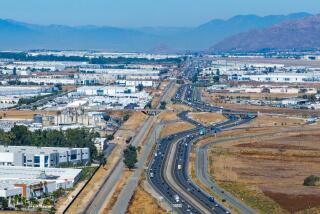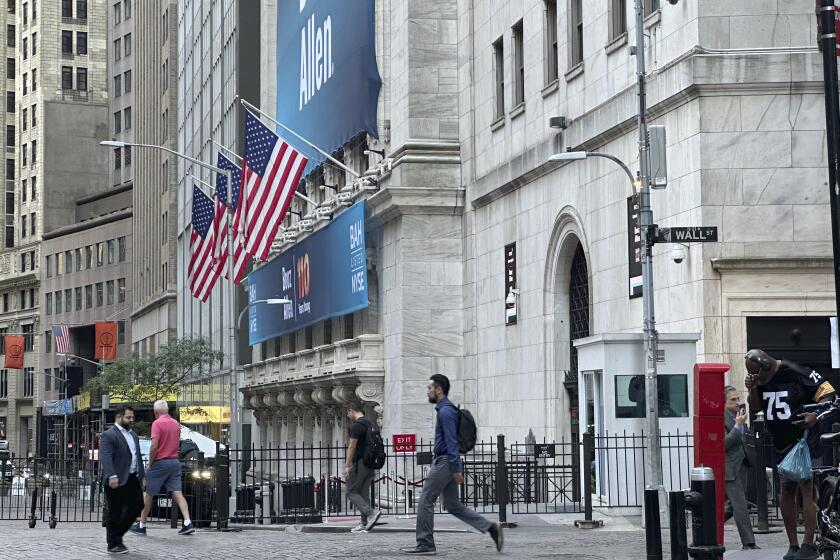By LEAPS and BOUNDS
- Share via
IRVINE — What started out as a bean field 13 years ago has sprouted into one of the country’s premier technology addresses.
The 3,600-acre Irvine Spectrum emerged relatively unscathed from the California recession two years ago and has been growing at breakneck speed ever since. All told, 2,200 companies employing more than 36,000 people now make their home in the business community cradled in the convergence of the Santa Ana and San Diego freeways.
For the record:
12:00 a.m. May 23, 1997 For the Record
Los Angeles Times Friday May 23, 1997 Orange County Edition Business Part D Page 6 Financial Desk 1 inches; 20 words Type of Material: Correction
Irvine Spectrum--Western Financial Bank was incorrectly identified in a graphic published Sunday on the Irvine Spectrum business park.
In fact, it has grown so fast that its developer, the Irvine Co., now expects the project to be completed in 25 years, instead of the 40 it had originally projected.
Recently, Irvine Co. has put on a full-court press by launching a national marketing campaign to lure technology companies from across the country.
Among its arsenal of promotional material are studies comparing it to well-established technology hubs like Silicon Valley, Boston’s Route 128 “Technology Highway” and the Research Triangle, a three-city area in North Carolina.
In fact, the company brags that its research and development space, or adaptable “flex-space” favored by high-tech firms, rivals or surpasses that of those major technology hubs.
“We’re probably the most successful of all of them for doing it as quickly as we did,” says Richard Sim, the Irvine Co.’s executive vice president.
Yet, many experts say that Irvine Spectrum will never be a national player--mainly because it doesn’t need to be.
*
The Spectrum is a uniquely Southern California phenomenon. The concentration of unassuming beige two-story buildings clustered around the freeways is designed to collect the “gazelles,” or fast-growing entrepreneurs, flowing out of the urban core of the L.A. basin.
In fact, most of the Spectrum’s entrepreneurs are executives who broke away from large regional firms to start their own companies and needed plentiful land and safe neighborhoods. Other areas of Southern California--Valencia and Chatsworth in Los Angeles County and Thousand Oaks in Ventura County--experienced similar, though much less explosive, growth.
“What you have is the history of high technology in the L.A. region. Companies are moving further and further out,” says Allen Scott, associate dean of UCLA’s school of public policy.
Experts say that getting company executives from elsewhere in the country to move to Southern California, with its congested traffic, expensive housing and higher cost of living, is difficult.
“It would take some very good marketing to convince people from the Midwest or the Southeast to come to California, not just Orange County or the Spectrum,” says Mark Baldassare, professor of urban planning at UC Irvine.
Instead, he said, the Spectrum’s growth spurt is coming from the further expansion of fast-growing local companies and the migration of corporate executives to Orange County’s suburban neighborhoods.
And as with so many of Southern California’s other newer communities, the Spectrum is a product of careful planning and rigid controls--things that natives have to expect to expect.
Whereas the Spectrum was built by one developer who still controls it, areas like the Research Triangle and Silicon Valley developed over decades, propelled by proximity to research universities and access to cheap land.
Sim of the Irvine Co. feels that planning will give the Spectrum the longevity that other business districts lack.
“Hollywood is never going to go anywhere because the infrastructure is in place. Same with Wall Street,” Sim says. “That’s what we are trying to create in the Irvine Spectrum.”
When Irvine Co. Chairman Donald L. Bren originally planned the park, he saw it simply as a haven for large headquarters and manufacturing facilities, not a technology center.
The developer was courting only big firms, especially the Japanese companies that were thriving in the heady business climate of the mid-1980s. But a real estate consultant changed his mind.
“They were ignoring the small companies and looking for the big build-to-suits. I said they were leaving out 20% of the market,” said Alfred Gobar, who worked with the Irvine Co. on its master plan.
Gobar’s estimate turned out to be an understatement.
To get the Spectrum off the ground, the Irvine Co. pumped more than $227 million into infrastructure, including palm-tree lined streets and the first privately financed freeway cloverleaf.
*
To recoup some of its initial investment, it sold land in the new park to developers--something it now refuses to do. Although the Irvine Co. managed to lure several firms in at the beginning, its real heyday was in the late 1980s as executives moved into the newer planned communities of south Orange County. Many simply decided they didn’t want to fight the traffic of a daily commute to central Orange County or Los Angeles. The Spectrum is close to the John Wayne Airport, and their companies could still attract a large labor pool for manufacturing work.
As more companies moved in, a network of suppliers and subcontractors sprang up, from prototype-manufacturing firms to graphic designers and attorneys, all buying and selling from one another, said UCLA’s Scott. The development got the name “Spectrum” as more and varied companies moved in.
Development in the Spectrum slowed during the recession of the early 1990s, but has rebounded in the last two years as the economy has regained its footing and companies have begun expanding again. Last year, the Irvine Co. built a dozen buildings in the Spectrum. This year almost twice that many are under construction, and it plans an additional 164 over the next five years, representing a $1-billion investment, according to Sim.
That hefty investment will include a new high-rise office building, one of the few in the area, which could break ground later this year. Construction also will begin on a cluster of small one-story buildings, which will house the Spectrum’s accounting and law firms that cater to high-tech companies.
And the Irvine Co. will start building six of its signature two-story office buildings to help accommodate tenants that need to expand.
Many of the companies in the Spectrum start out leasing 1,000 square feet in one of the center’s small office buildings, then graduate to a larger building. Eventually--sometimes within just a few years--they build their own headquarters.
These small but fast-growing firms have become the backbone of the Spectrum and have fueled further spinoffs. A whopping 77% of the Spectrum’s companies employ 24 employees or fewer, according to a company study.
*
In fact, only a few of the Spectrum’s tenants have recognizable names, like disk-drive manufacturer Western Digital Corp. and Japanese auto and electronic makers Toshiba Corp. and Mazda Motor Corp., which have their U.S. headquarters there.
“The whole trend in the high-tech industry is toward these small firms producing very specialized products in relatively small quantities,” Scott said. “These leading-edge firms just keep spinning off in a constant turmoil of innovation.”
Paul Mikus moved his prostate treatment company, Endocare Inc., into the Spectrum in 1995 after it was spun off from Aliso Viejo-based Medstone International.
He picked the Spectrum because of its reputation as a breeding ground for gazelle companies and for its no-frills, sterile environment that sends a message to investors that money is not squandered.
Also important, the chairman and CEO said, is the short commute allows him to get home in time to take a walk in the canyons by his home in Aliso Viejo.
Wonderware Corp., a maker of automation software, got its start in the Irvine Spectrum in 1988 when then-Chief Executive Dennis Morin and a handful of others set up shop in a 700-square-foot office on Technology Drive.
*
There wasn’t much around them, he recalls, just the AT&T; office tower on Irvine Center Drive and a few small office buildings nestled among agricultural fields. Nine months after moving in, the company got an infusion of venture capital. Morin went back to the Irvine Co. and asked for an additional 3,300 feet of space to expand. There wasn’t any available in the building, so it had to get creative.
“For the next two years we bribed four different companies to move out,” Morin said. Five years later the company built its own headquarters, and it has swallowed up four other buildings since then.
Once moved in, most companies stay, despite high rents and rigid guidelines that prohibit colorful corporate signs and all but a few types of architecture. Company CEOs say it would be just as expensive to move and that then they couldn’t be as close to their homes.
“We’ve never thought of moving anywhere else,” said Jay Amestoy, a vice president with Mazda Motors of America, the U.S. headquarters of the Japanese auto manufacturer.
“Our executives are familiar with Orange County and think it is a prestigious place to do business.” In particular, top brass overseas likes the park’s access to a wide variety of golf courses, he said.
But workers have complained for years that they are virtually imprisoned in the Spectrum.
Although the industrial park is surrounded by residential neighborhoods of Irvine, Lake Forest and Laguna Hills, it took more than 10 years for the developer to build the Irvine Entertainment Center, and to sell land for the first fast-food outlet or gas station. Two years ago, Morin ran out of gas driving through the Spectrum.
“About a half-mile from my office, my car died,” he recalled. “You try breaking down in the Spectrum on a Sunday afternoon. There’s nobody around.”
Sim said the place was so deserted at night that retailers didn’t want to move there.
“We even offered 10 years of free rent to a gas station one time,” he said.
Things improved in 1995, when the Irvine Co. opened its neon colossus, the Irvine Entertainment Center, which contains upscale restaurants and a food court.
A 250,000-square-foot second phase of the entertainment center is scheduled to break ground this summer. This new addition to the Moorish-themed center will contain lower-priced restaurants and entertainment.
It will also serve as the heart of a new “downtown” that the Irvine Co. is trying to fashion near Irvine Center Drive and the San Diego Freeway. Sim said the company will recruit a full-service hotel, build a few more high-rises and add 500,000 square feet of shops and entertainment before the park is complete.
“This will be the gathering place for all of the high-tech companies,” Sim said.
The Irvine Co. hopes these additions attract larger tenants and also help it retain the growing companies they have. With 1,400 acres left to be developed, the Spectrum still has a long way to go before reaching its goal of 5,000 companies employing 150,000 workers.
And it is starting to face some stiff competition from competing parks like Pacific Commercentre in Lake Forest, Foothill Ranch Corporate Center and Aliso Viejo’s Pacific Park, which have cheaper land and fewer building restrictions.
Indeed, the Spectrum has been a godsend to these neighboring parks, providing a number of tenants who like south Orange County but don’t care about having the prestigious Spectrum address.
“People come here because it’s the next-closest thing,” said Norman Nowell, president of Makena Properties in Lake Forest, which operates Pacific Commercentre. “We’ve definitely benefited from the Spectrum being there.”
(BEGIN TEXT OF INFOBOX / INFOGRAPHIC)
Positioned for Growth
The 3,600-acre Irvine Spectrum (in shaded area, above) is home to corporate giants and small start-ups. During the last decade, the number of firms in the area has grown sixfold and employment has tripled. This rapid expansion will continue as the Irvine Co., which owns most of the land, adds office, industrial and retail space on another 1,400 acres of new development. A look at the Irvine Spectrum now:
Spectrum Growth
Companies
1984: 250
1987: 360
1989: 600
1994: 2,000
1997: 2,200
*
Employees
1984: 2,500
1987: 12,000
1989: 16,000
1994: 32,000
1997: 36,000
Major Tenants
* Western Digital
* AT&T; regional headquarters
* Mazda Motors of America
* Motorola Inc. (computer and semiconductor groups)
* Toshiba America Information Systems
Latest Developments
Some projects under construction or about to begin:
Irvine Spectrum Center
What: Second phase of Irvine Co.’s plans for a major retail complex that includes the Irvine Entertainment Center, completed in 1995
Size: 250,000 square feet
Mossimo
What: Headquarters, warehouse and distribution center
Size: 208,540 square feet
Meade Instrument Corp.
What: Corporate headquarters
Size: 165,000 square feet
Nikken
What: North American and European headquarters
Size: 213,000 square feet
AutoNation USA
what: Used car superstore
Size: 20 acres
Western Digital
What: Purchasing land to build campus-like corporate headquarters complex
Size: 33 acres
Union Foods
What: Ramen noodle manufacturing facility
Size: 167,000 square feet
Western Financial Savings
What: Office building
Size: 100,000 square feet
Irvine Co.
What: Various office buildings including a new high-rise
Size: 20 buildings
Source: Irvine Co., Times reports; Researched by JANICE L. JONES / Los Angeles Times






